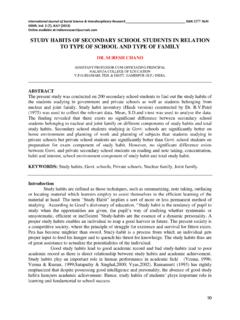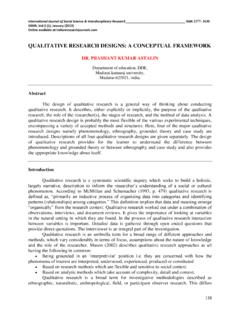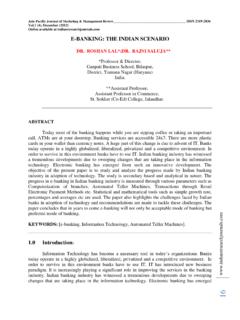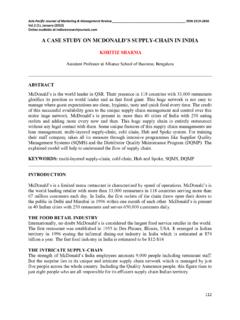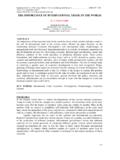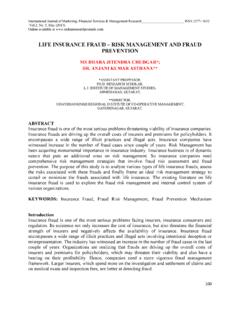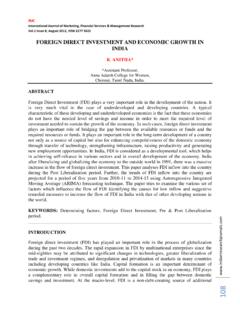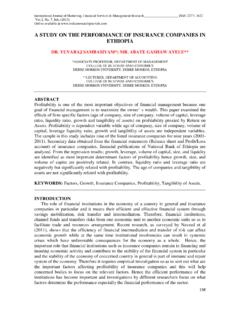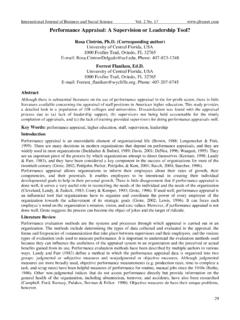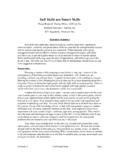Transcription of TRANSFORMATIONAL LEADERSHIP APPROACH IN …
1 International Journal of Social Science & Interdisciplinary Research_____ ISSN 2277 3630 IJSSIR, Vol. 2 (3), MARCH (2013) Online available at 155 TRANSFORMATIONAL LEADERSHIP APPROACH IN ORGANISATIONS -ITS STRENGTHS AND WEAKNESSES SURESH. A*; RAJINI. J** *RESEARCH SCHOLAR IN THE DEPARTMENT OF COMMERCE AND BUSINESS MANAGEMENT, KAKATIYA UNIVERSITY, WARANGAL AND WORKING AS A FACULTY IN COMMERCE & BUSINESS MANAGEMENT IN UNIVERSITY ARTS AND SCIENCE COLLEGE, SUBEDARI, WARANGAL . **WORKING AS A FACULTY IN COMMERCE & BUSINESS MANAGEMENT IN UNIVERSITY ARTS AND SCIENCE COLLEGE, SUBEDARI, WARANGAL . _____ Introduction LEADERSHIP has been described as a process of social influence in which one person can enlist the aid and support of others in the accomplishment of a common task".
2 LEADERSHIP is "organizing a group of people to achieve a common goal". The leader may or may not have any formal authority. Students of LEADERSHIP have produced theories involving traits, situational interaction, function, behavior, power, vision and values, charisma, and intelligence, among others. Somebody whom people follow: somebody who guides or directs role every manager must fill in the workplace is LEADERSHIP . Managers often make the mistake of assuming that because they are the managers, they are also the leaders and that their associates will automatically follow. In reality, position only denotes title, not LEADERSHIP .
3 Peter Northouse (2001) defines LEADERSHIP as a process whereby one individual influences a group of individuals to achieve a common goal. To be an effective leader, the manager must influence his associates in a positive way to reach the goals of the organization. There are three types of LEADERSHIP approaches. They are 1) Transactional LEADERSHIP : It focuses on the exchanges that occur between leaders and their followers. 2) TRANSFORMATIONAL LEADERSHIP : Process of engaging with others to create a connection that increases motivation and morality in both the leader and the follower. Leader is attentive to the needs and motives of followers and tries to help followers reach their fullest potential.
4 3) Pseudo TRANSFORMATIONAL LEADERSHIP : It focuses on the leader s own interests rather than the interests of their followers. Of the above three the TRANSFORMATIONAL LEADERSHIP APPROACH can help managers become exceptional leaders. This paper will explain the TRANSFORMATIONAL LEADERSHIP APPROACH by discussing its components, factors, strengths, weaknesses, and steps for application. TRANSFORMATIONAL LEADERSHIP is a process of transforming the organizational behavior, the culture and the individuals; simultaneously transforming the leader himself. Transactional LEADERSHIP , also known as managerial LEADERSHIP , focuses on the role of supervision, organization, and group International Journal of Social Science & Interdisciplinary Research_____ ISSN 2277 3630 IJSSIR, Vol.
5 2 (3), MARCH (2013) Online available at 156 performance; transactional LEADERSHIP is a style of LEADERSHIP in which the leader promotes compliance of his followers through both rewards and punishments. TRANSFORMATIONAL leaders constantly articulate new visions to motivate the organization, they exhibit high passion and confidence in their beliefs, they give importance to ethics and values while setting accountable standards in the organization. TRANSFORMATIONAL leaders are often charismatic who are able to have an exceptional influence on their followers, compelling them to share the leader s vision and to take actions beyond their specified responsibilities.
6 TRANSFORMATIONAL leader s exhibit good organizational abilities, they are able to align the individual aspirations and motivations to that of organization s vision. Components of TRANSFORMATIONAL LEADERSHIP Two major components of TRANSFORMATIONAL LEADERSHIP are (1) Charismatic LEADERSHIP (2) Stewardship and servant LEADERSHIP Charismatic Leaders Traditionally, charisma is defined as perception of divine, exceptionally gifted qualities of a leader. It is this perception of extraordinary that compels the followers to believe in their leader s radical vision rather than any rational judgment. Charismatic leaders have exceptional abilities to influence their followers, they are strong role models and the followers want to emulate their behavior.
7 They are very well respected and deeply trusted by their subordinates. Charismatic leaders by nature have high capacity to transform the organization and its environment, though some contend that it s not essential component of TRANSFORMATIONAL LEADERSHIP . It s true that transformations can also be accomplished by following a more ethical code, more consideration of subordinate interests and development, however without charisma , it would be a mere inanimate process without any human touch. Some of the key characteristics of Charismatic LEADERSHIP are Vision: Charismatic leaders have natural inclination to be dissatisfied with status-quo and always search for a radically different vision.
8 Learn more about vision in LEADERSHIP purpose. Strong LEADERSHIP traits: Charismatic leader develop all the necessary traits of LEADERSHIP , ability to inspire, establish credibility and are very strong in their communication skills. Strong Self-Belief: Charismatic leader have strong inner conviction about their vision and strategies. They have gone through the phases of inner turmoil and have successfully overcome their inner conflicts to realize their full potential. The completion of self discovery results in exceptional confidence, an attribute that only makes them more compelling and dominant. Activist Mindset: Their inner conviction and desperation for change makes them self-promoting for their cause and belief.
9 They are willing to pursue risky endeavors, their courageousness is a great influence on the followers, and people expect and admire leaders who are courageous. International Journal of Social Science & Interdisciplinary Research_____ ISSN 2277 3630 IJSSIR, Vol. 2 (3), MARCH (2013) Online available at 157 Exemplary: Charismatic leaders practice high moral values, they are very ethical in their actions and follow a code of conduct at the expense of self. Servant LEADERSHIP Servant LEADERSHIP is employee-oriented process that aims to empower subordinates with greater ownership and responsibilities while the leader acts as self-sacrificing facilitator.
10 However this doesn t imply that leader is less concerned with the business or other objectives of the organization, but rather formulates a collective vision that serves both employees and the organization s stakeholders. Some of the key characteristics of servant LEADERSHIP are:- Create atmosphere of partnership: Servant leaders consciously desist from using their positional power unless really required. They try to lead at the ground level, considerably eliminating the perception of organizational hierarchy. Active Listener: Servant leaders are more like negotiators rather than commanders; they listen carefully to the problems of others and then engage in range of satisfying solutions.
